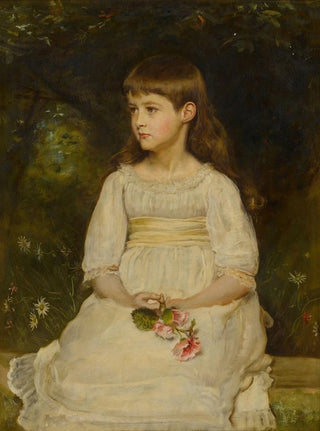Art print | Portrait of Miss Scott, daughter of the late Thomas Alexander Scott of Philadelphia - Sir John Everett Millais


View from behind

Frame (optional)
The art print "Portrait of Mlle Scott, daughter of the late Thomas Alexander Scott of Philadelphia" by Sir John Everett Millais is an iconic work of the Pre-Raphaelite movement, which marked a significant chapter in art history in the 19th century. Created in 1878, this piece captures not only the beauty and grace of its model but also the very essence of an era where art sought to redefine aesthetic standards. Observing this portrait, the viewer is transported into a universe where every detail, every color, and every shadow seem to tell a story. The delicacy of Mlle Scott's face, along with the expression of her gaze, evoke an emotional depth that leaves a lasting impression. Millais succeeds in immortalizing a personality while playing with the symbolic elements of his time, making this work timeless.
Style and uniqueness of the work
Millais's style in this art print is distinguished by meticulous attention to detail and bold use of color. His painting technique, blending realism and romanticism, gives an almost lifelike dimension to the subject. The drapes of Mlle Scott's dress, with their shades of blue and green, harmoniously contrast with the softness of her complexion. The background, subtly blurred, allows focus to be drawn to the face of the model, thus emphasizing her presence. Millais, a true master of light, plays with reflections and shadows to bring this intimate scene to life. Every element, from the delicate jewelry to the texture of the fabrics, is carefully thought out, demonstrating exceptional craftsmanship. This art print is not just a simple portrait; it is a true ode to feminine beauty and the technical virtuosity of its creator.
The artist and his influence
Sir John Everett Millais, a central figure of the preraphaelite movement, contributed to redefining the artistic conventions of his time. Born in 1829, he co-founded the preraphaelite brotherhood with Dante Gabriel Rossetti and William Holman Hunt, seeking to move away from academic standards in favor of a more authentic and emotional approach.

Matte finish

View from behind

Frame (optional)
The art print "Portrait of Mlle Scott, daughter of the late Thomas Alexander Scott of Philadelphia" by Sir John Everett Millais is an iconic work of the Pre-Raphaelite movement, which marked a significant chapter in art history in the 19th century. Created in 1878, this piece captures not only the beauty and grace of its model but also the very essence of an era where art sought to redefine aesthetic standards. Observing this portrait, the viewer is transported into a universe where every detail, every color, and every shadow seem to tell a story. The delicacy of Mlle Scott's face, along with the expression of her gaze, evoke an emotional depth that leaves a lasting impression. Millais succeeds in immortalizing a personality while playing with the symbolic elements of his time, making this work timeless.
Style and uniqueness of the work
Millais's style in this art print is distinguished by meticulous attention to detail and bold use of color. His painting technique, blending realism and romanticism, gives an almost lifelike dimension to the subject. The drapes of Mlle Scott's dress, with their shades of blue and green, harmoniously contrast with the softness of her complexion. The background, subtly blurred, allows focus to be drawn to the face of the model, thus emphasizing her presence. Millais, a true master of light, plays with reflections and shadows to bring this intimate scene to life. Every element, from the delicate jewelry to the texture of the fabrics, is carefully thought out, demonstrating exceptional craftsmanship. This art print is not just a simple portrait; it is a true ode to feminine beauty and the technical virtuosity of its creator.
The artist and his influence
Sir John Everett Millais, a central figure of the preraphaelite movement, contributed to redefining the artistic conventions of his time. Born in 1829, he co-founded the preraphaelite brotherhood with Dante Gabriel Rossetti and William Holman Hunt, seeking to move away from academic standards in favor of a more authentic and emotional approach.






